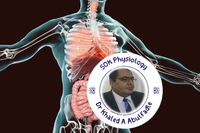admin
Admin

عدد المساهمات : 9696
تاريخ التسجيل : 06/08/2009
 |  موضوع: Case study on thyroid disorder موضوع: Case study on thyroid disorder  الأحد نوفمبر 07, 2010 5:47 am الأحد نوفمبر 07, 2010 5:47 am | |
| History
A 50-year-old man presents with enlargement of left anterior neck. He has noted increased appetite over past month with no weight gain, and more frequent bowel movements over the same period.
Physical Exam
He is 5'8" tall and weighs 150 lb. The heart rate is 82 and the blood pressure is 110/76. There is an ocular stare with a slight lid lag. The thyroid gland is asymmetric to palpation, weighing an estimated 40g (normal = 15-20g). There is a 3 x 2.5 cm firm nodule in left lobe of the thyroid.
What do you think the patient's primary problem is?
Probable Hyperthyroidism
--------------------------------------------------------------------------------
The history of increased appetite (without weight gain) and increased bowel motility is classic for hyperthyroidism. The resting heart rate is mildly elevated, which is consistent but is a common finding in physician's offices. The findings of an ocular stare, lid lag, and an enlarged thryoid are also consistent with hyperthyroidism.
The orbital symptoms noted here are most typically associated with Grave's disease and result from inflammation and swelling of retro-orbital tissues (this effect is separate from the elevation in thryoid hormone). However, in this case the thyroid is asymmetrical and contains a nodule, whereas the thyroid gland in Grave's disease is symmetrically enlarged and homogeneous.
Initial evaluation of a patient's thyroid status is most commonly done by measuring thryoid stimulating hormone (TSH) concentration in the serum, which is a sensitive indicator of the body's perception of its own thryoid status. In hyperthyroidism, TSH concentration is markedly decreased (the converse is true in hypothyroidism). Usually, serum free T4 will be measured as well and can serve as a confirmatory test for the TSH findings. In some labs, free T4 assay is not routinely available; similar data can be derived from measuring total T4 and T3 resin uptake, and calculating the Free Thyroxine Index (FTI) which is proportional to free T4.
In this patient, there is a nodule associated with the thyroid gland. This finding might result from thyroid pathology but might also indicate a parathyroid adenoma (which would appear in the same area). Thus it is prudent to check the patient's calcium status. Active parathyroid adenomas produce hypercalcemia and may also be associated with marked elevations in circulating alkaline phosphatase (due to active bone resorption).
The test results for this patient were as follows (S = measured in serum):
Patient's value Reference range
Calcium, total (S) 10.6 mg/dl 8.4 - 10.2
Phosphorus 4.8 mg/dl 2.7 - 4.5
Alkaline phosphatase (S) 160 U/L 49 - 120
T4, Total (S) 12.2 ug/dl 5 - 11.5
T3 resin uptake (S) 35% 25 - 35
T3, Total (S) 311 ng/dl 100 - 215
TSH (S) <0.1 uU/ml 0.7 -7.0
Free thyroxine index (FTI) 14.6 6 - 11.5
How would you interpret these results?
The most important result is the strongly suppressed TSH (the labs are shown again below). The remainder of the thyroid tests are also consistent with hyperthyroidism (elevated FTI and T3). The tests for parathyroid problems do not rule out a parathyroid process (though the alkaline phosphatase is only very mildly elevated).
What additional tests would you order?
Further testing
--------------------------------------------------------------------------------
Additional testing should directly address the possibility of Grave's disease and should also determine the nature of the nodule associated with the thyroid (testing so far has been inconclusive regarding the nodule). Grave's disease is strongly associated with the presence of anti-thyroid microsomal antibodies, while other antibodies against thyroid epitopes (e.g., thyroglobulin) occur in Hashimoto's thyroiditis. Furthermore, the thyroid hyperfunction that occurs in Grave's disease can be assessed directly by measuring the rate radio-iodine uptake into the thyroid gland.
Serum was obtained for anti-thyroid antibody testing and the following results were obtained:
Patient Normal
Antithyroglobulin Ab. neg. neg.
Antimicrosomal Ab. pos. (1:1280) neg.
A thyroid scan to evaluate the uptake of radioactive iodine into the thyroid gland showed 68% uptake at 6 hr and 54% uptake at 24 hr after treatment with iodine-123 (normal 5 - 28% uptake at these time points). The radio-iodine uptake was homogeneously increased over the entire gland except in the area of the palpable nodule, where uptake was decreased.
How would you interpret these additional tests?
Consistent with Grave's disease
--------------------------------------------------------------------------------
The anti-thyroid antibody tests and radio-iodine uptake results make a diagnosis of Grave's disease solid at this point. However, the finding that radio-iodine uptake is decreased in the area of the nodule suggests that there is an additional problem in the thyroid gland that is separate from Grave's disease.
What would you wish to do next to finalize the diagnosis?
Diagnosis and course
--------------------------------------------------------------------------------
The finding of a low radio-iodine uptake into the palpable nodule suggests that a thyroid neoplasm might be present. A tissue diagnosis is needed to fully evaluate that possibility, so a fine needle aspirate (FNA) of the nodule was made and the cytology of the recovered cells was examined.
The diagnosis from the FNA was papillary carcinoma of the thyroid, and the final diagnosis for the patient was:
Grave's disease with papillary carcinoma
Course
The patient underwent surgical thyroidectomy followed by thyroid hormone replacement therapy. Later, he was scanned for residual thyroid tissue, which was ablated with iodine-131. He underwent periodic serum thyroglobulin analysis and iodine-131 scans, which remained negative over a two-year course.
Recently, ocular tearing and itching with proptosis were noted on physical exam.
Are these ocular symptoms suggestive of a recurrent thyroid problem (e.g., recurrent tumor) in this patient?
No.
--------------------------------------------------------------------------------
Remember that Grave's disease is a systemic autoimmune process that has hyperthyroidism as one of it's manifestations. The removal of the thyroid gland cures the hyperthyroidism, but not the other symptoms of Grave's disease--which include the ocular symptoms.
            | |
|
